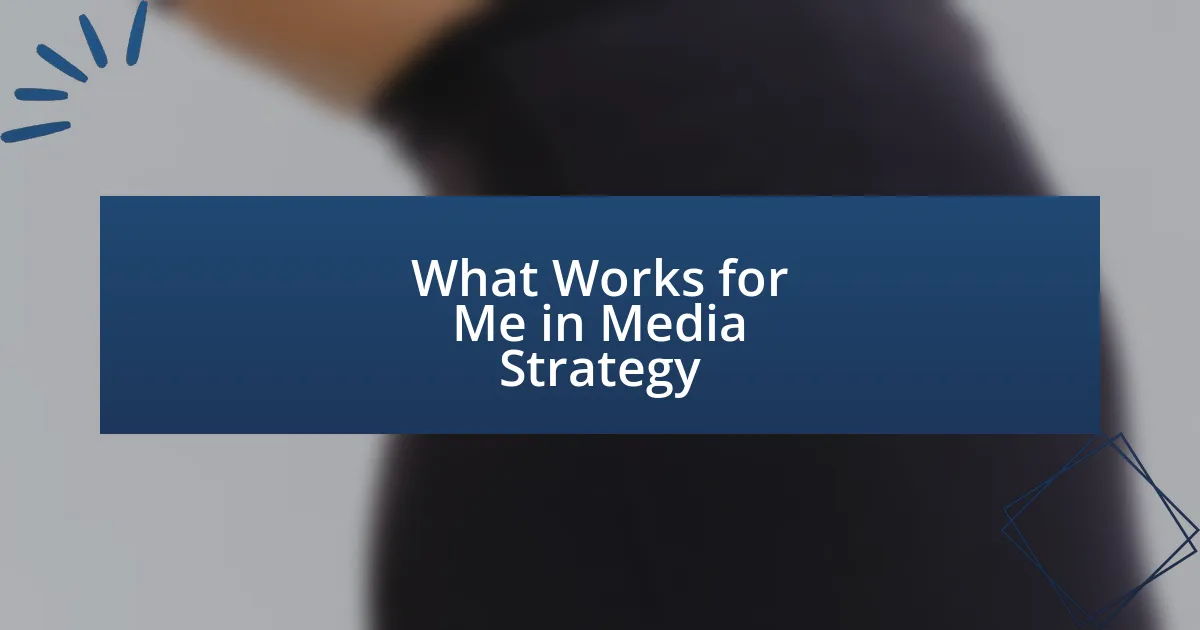Key takeaways:
- Media impact metrics translate audience engagement into actionable insights, including reach, sentiment, and conversion rates.
- Audience engagement is measured through comments, social shares, time spent on page, click-through rates, and demographics.
- Analyzing content reach and conversion rates helps refine strategies and highlights the importance of personal storytelling.
- Adjusting strategies based on insights, such as content timing and updates, enhances audience connection and retention.
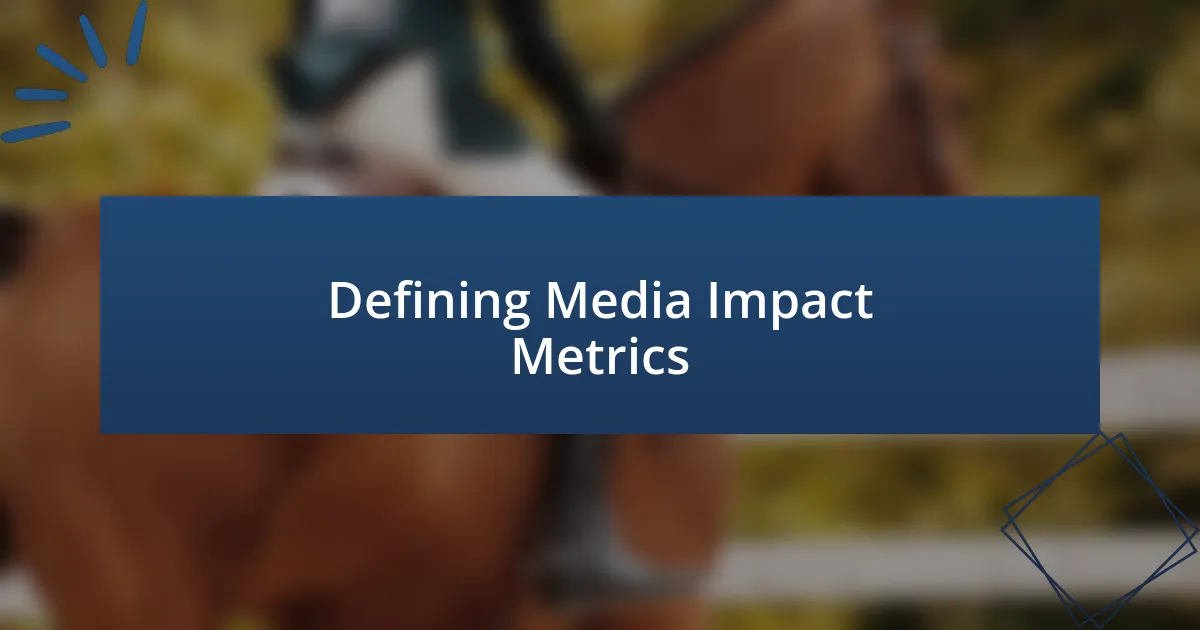
Defining Media Impact Metrics
When I think about media impact metrics, I consider how they translate engagement into actionable insights. For example, after posting a new article, I closely monitor metrics like shares and comments, which reveal how deeply my audience resonates with the content. Have you ever analyzed why a particular post soared while another fizzled? It’s a puzzle worth exploring.
One of my go-to metrics is the reach of my media efforts. It’s fascinating to see how a single piece can ripple through different platforms, sometimes gaining traction in unexpected places. I recall a time when a blog post I wrote about sustainability was shared by a prominent influencer, opening doors to conversations I never anticipated.
Another crucial metric for me is audience sentiment. Understanding how my audience feels about my work helps refine my voice and topics. Reading through comments and reactions makes me reflect: am I truly connecting, or am I missing the mark? That emotional feedback is invaluable; it shapes not just what I write, but how I grow as a communicator.
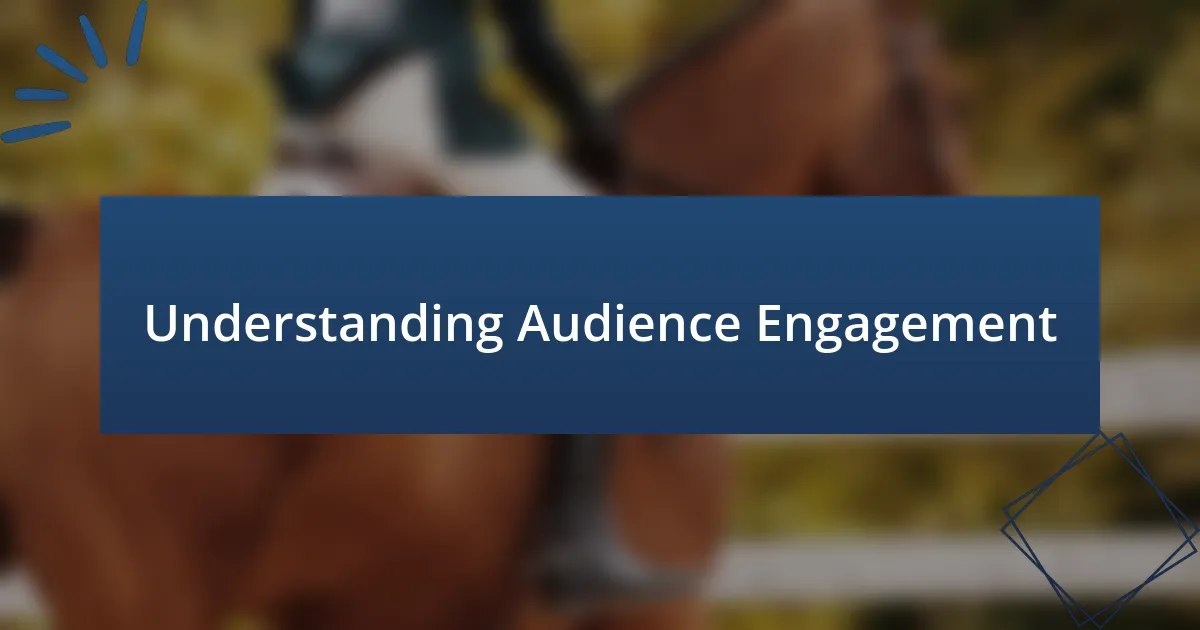
Understanding Audience Engagement
Engaging with my audience is an intricate dance of understanding their preferences and behavior. I find it rewarding when I see spikes in engagement; it tells me that my message struck a chord. Recently, I shared a behind-the-scenes look at my creative process, and the flood of comments from readers sharing their own experiences was incredible. It was a genuine moment of connection that highlighted how we can all relate on a human level.
To effectively grasp audience engagement, I focus on several key elements:
– Comments and Replies: They provide immediate feedback on what resonates with my readers.
– Social Shares: A strong indicator of value; when people share, it means they find the content worth spreading.
– Time Spent on Page: Longer visits often suggest deeper interest or identification with the material.
– Click-Through Rates: They help me understand how enticing my headlines are and how well they motivate readers to explore further.
– Audience Demographics: Knowing who engages with my work helps tailor future content to their interests and needs.
Each of these components adds a layer to my understanding, guiding me in crafting more meaningful and impactful content.

Analyzing Content Reach
Analyzing how far my content reaches is crucial in assessing its overall impact. I remember a time when I posted a piece that unexpectedly went viral, reaching audiences I had never imagined connecting with. It was exhilarating to see the metrics light up—views rolling in from different countries, and I felt a sense of pride knowing my words resonated widely.
I track metrics like impressions and engagement rates regularly to understand reach effectively. Impressions show how many times my content was displayed, even if it wasn’t clicked. In contrast, engagement rates reflect active interaction, offering a clearer picture of my audience’s interest and connection to the content. The difference can be substantial; for instance, a post with high impressions but low engagement may suggest it wasn’t compelling enough to draw in readers’ attention.
Additionally, I look at referral traffic sources to see which platforms send the most visitors my way. Analyzing trends in this data over time often reveals interesting insights. For instance, a recent article I shared on LinkedIn performed exceptionally well compared to other platforms, leading me to rethink my content distribution strategy. This experience underscored the importance of not only creating valuable content but also understanding where and how it reaches my audience.
| Metric | Importance |
|---|---|
| Impressions | Shows visibility and potential audience size |
| Engagement Rate | Indicates how compelling the content is |
| Referral Traffic | Highlights which platforms drive audience interaction |
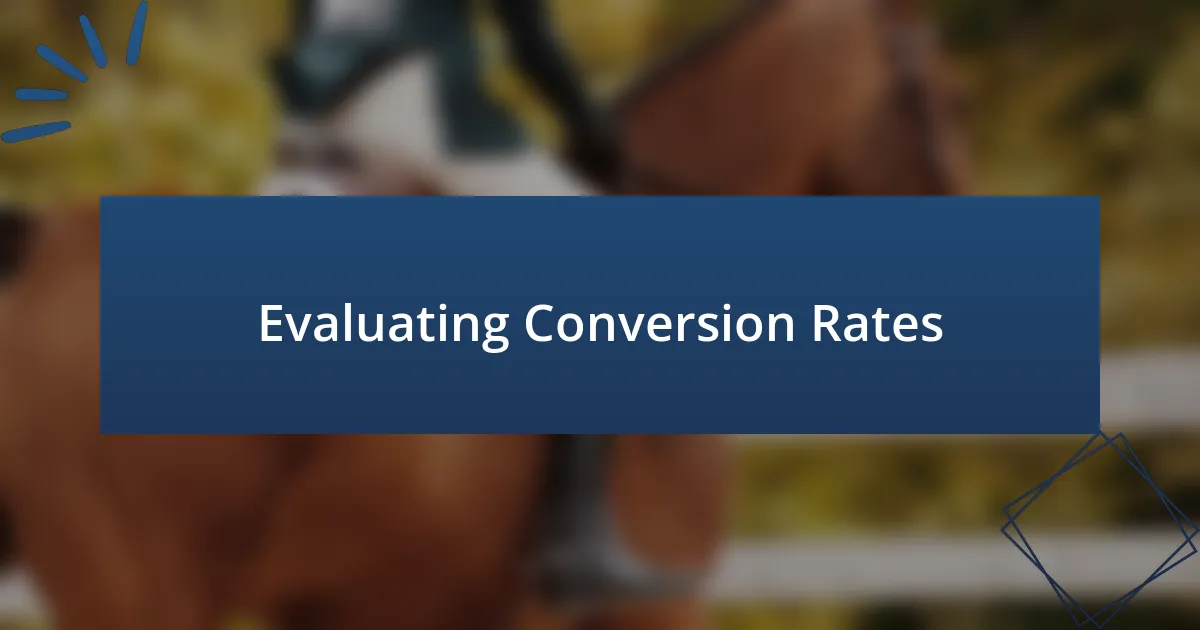
Evaluating Conversion Rates
Once I started measuring conversion rates, I realized how much they reveal about my content’s effectiveness. For instance, after a webinar I hosted, I tracked the number of sign-ups compared to the total attendees. Seeing a conversion rate of 30% was thrilling—it showed me that my presentation not only attracted interest but prompted real action, validating my efforts.
I always remind myself that a good conversion rate isn’t just about the numbers; it’s about understanding my audience’s needs. When I launched an e-book, I was initially disappointed when the downloads didn’t meet my expectations. However, digging deep into the data, I discovered that the landing page wasn’t compelling enough. This insight led me to refine my messaging, resulting in a much-improved rate.
Evaluating conversion rates regularly helps me adapt my strategies. After releasing a series of blog posts, I found the one that garnered the highest conversion rates also had the most emotional storytelling. Coincidentally, this post included my personal journey, which resonated with readers. It made me wonder: how often are we underestimating the power of personal connection in driving conversions? Each evaluation cycle teaches me that the human touch can significantly influence results.
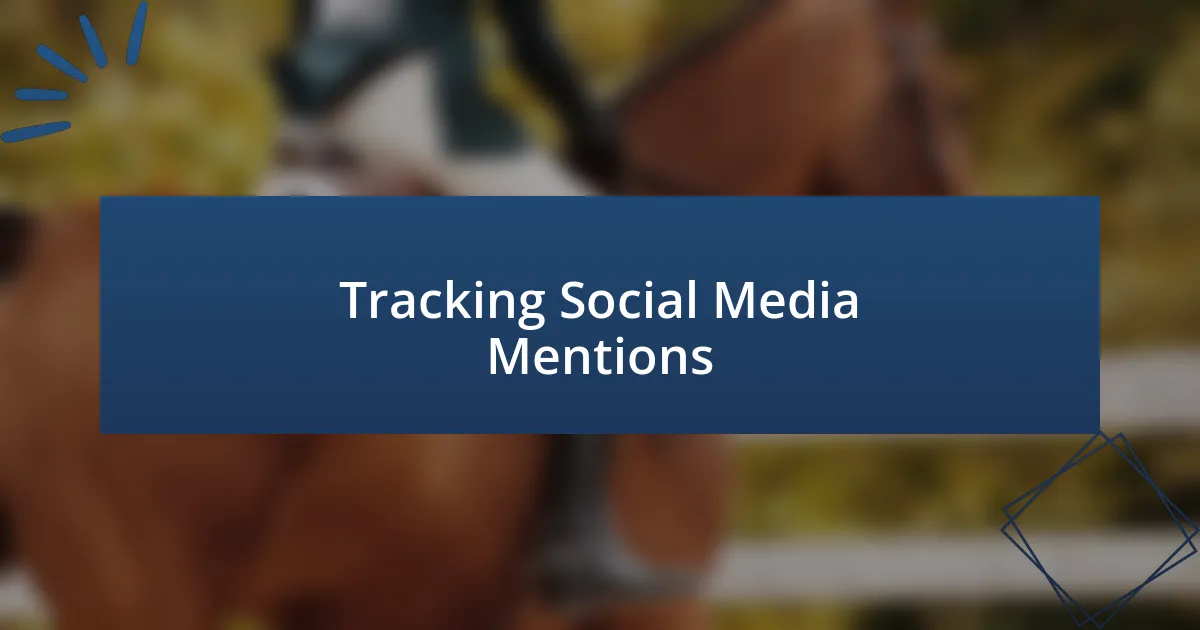
Tracking Social Media Mentions
Tracking social media mentions has become a vital part of my strategy. Whenever I post content, I make it a point to monitor the conversations around it. I remember the first time I spotted an unexpected mention of my work on a popular influencer’s page; the surge in engagement was exhilarating. It made me realize how much social media can amplify my reach when the right voices highlight my content.
To keep a pulse on these mentions, I rely on tools that aggregate social media activity. My go-to tool not only helps me find mentions but also tracks sentiment analysis. This feature has been eye-opening. For instance, a campaign I launched received both praise and criticism, but understanding the sentiment helped me further enhance my messaging. It begs the question: how can we leverage both positive and negative feedback to grow?
I often reflect on a specific moment when a follower tweeted about how my content transformed her perspective. That single mention not only boosted my morale but also affirmed the impact of my work. It’s a reminder that behind every statistic, there’s a person whose experience can shape my future content. How often do we take the time to appreciate the human connections behind our metrics?
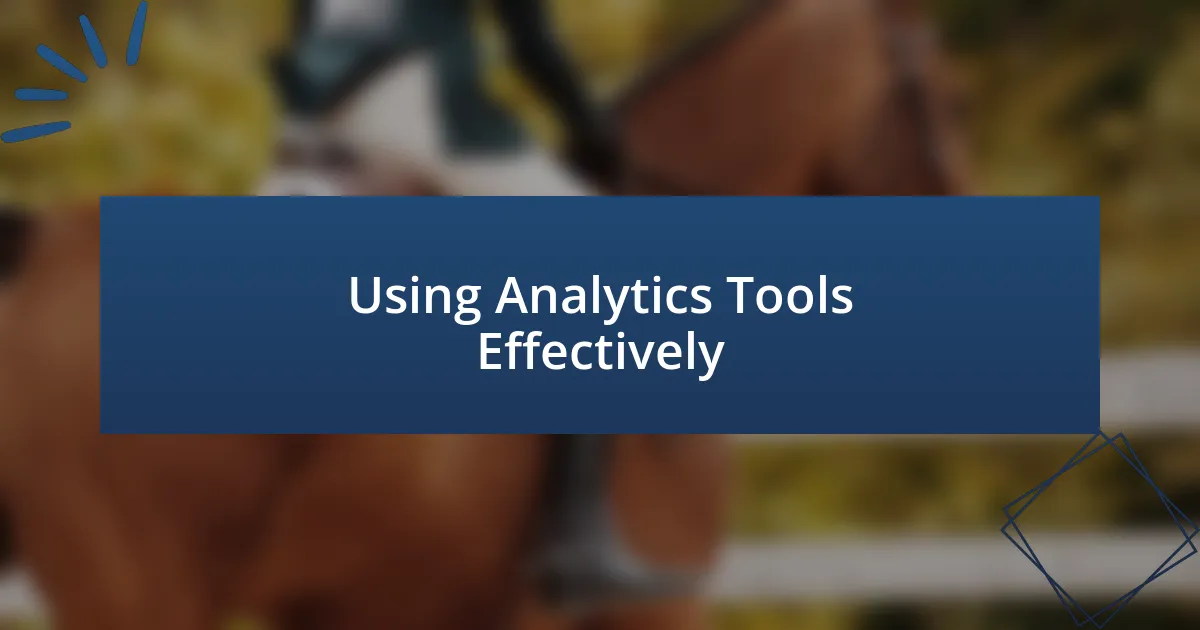
Using Analytics Tools Effectively
Using analytics tools effectively comes down to knowing which metrics to focus on. For me, it was a journey of discovery. Initially, I often got lost in the numbers. But once I zeroed in on engagement rates and conversion metrics, everything changed. The realization that not every view counts was liberating. Focusing on quality over quantity made my content more meaningful.
Every month, I analyze the performance of my posts using a combination of analytics dashboards. I remember this one time my monthly report highlighted a surprising spike in traffic from a blog post I wrote months ago. By digging deeper into the analytics, I found that it was linked to a trending topic. This insight taught me the importance of being adaptable—recognizing that audience interests can shift, and we must be ready to pivot our strategies. Isn’t it fascinating how a single post can revive a conversation long after its original publication?
Moreover, utilizing customized reports is invaluable to my process. Instead of relying solely on standard metrics, I tweak my reports to reflect what resonates with my brand and audience. This tailoring has provided me insights I didn’t even anticipate. For example, by highlighting demographic data, I discovered a significant portion of my audience was from a different age group than I originally thought. What a revelation! This kind of insight can redefine how I approach my content creation and engagement strategies. Have you ever had an analytics surprise that reshaped your understanding of your audience?

Adjusting Strategies Based on Insights
Adjusting strategies based on insights is crucial for my growth. I once noticed that my social media posts performed well on weekends rather than weekdays. This prompted me to shift my posting schedule, maximizing my content’s visibility. Have you ever thought about how timing might change your engagement?
Sometimes, I find myself revisiting older content after gaining new insights. Recently, I re-evaluated a series of articles I had written a year ago through the lens of current audience interests. I discovered that updating them with fresh data and perspectives led to a renewed interest and engagement. It’s surprising how a little tweak can breathe new life into existing work.
Additionally, I hold brainstorming sessions with my team when we see significant trends in the analytics. I recall a few months back when we identified a sudden interest in sustainability among our readers. This prompted us to create a focused series on eco-friendly practices, proving that responsive strategy can not only retain audience interest but can also deepen our connection with the community. How proactive are you in adapting your content to your audience’s evolving preferences?




